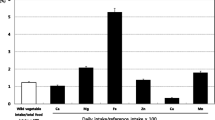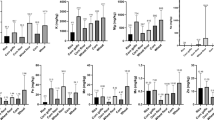Abstract
Tofu is one of the most consumed soybean products. Currently, tofu is consumed in vegan and vegetarian diets to avoid meat. However, it is necessary to determine the content of essential elements to assess the dietary intake. Essential elements (Na, K, Mg, Ca, Mn, Zn, Fe, Cu, Mo, Co) were determined in 130 samples of tofu by ICP-OES (inductively coupled plasma optical emission spectroscopy). The highest element content was found in flavoured tofu; the most notable were Na (2519 mg/kg wet weight) and Fe (19.5 mg/kg ww). Consumption of 200 g/day of flavoured tofu by adults would mean a high contribution of Cu (46.9% women, 38.1% men), Fe (55.7% women, 65.0% men) and Na (25.2% adults) to its AI (adequate intakes) sets by the EFSA (European Food Safety Authority). Natural tofu would mean a remarkably Mn contribution (50% adults) to the AI. Tofu could be an important source of essential elements such as Mg, Mn, Na, Cu and Fe.
Similar content being viewed by others
References
Serrazanetti DI, Ndagijimana M, Miserochi C, Perillo L, Guerzoni ME (2013) Fermented tofu: enhancement of keeping quality and sensorial properties. Food Control 34:336–346
Xu L, Du B, Xu B (2015) A systematic, comparative study on the beneficial health components and antioxidant activities of commercially fermented soy products marketed in China. Food Chem 174:202–213
Fang CY, Tseng M, Daly MB (2005) Correlates of soy food consumption in women at increased risk for breast cancer. J Am Diet Assoc 105:1552–1558
Meng S, Chang S, Gillen AM, Zhang Y (2016) Protein and quality analyses of accessions from the USDA soybean germplasm collection for tofu production. Food Chem 213:31–39
IPAD (International Production Assessment), FAS (Foreign Agricultural Services), USDA (United States Department of Agriculture) (2020) FAS home. IPAP Home Country Summary Production summary https://ipadfasusdagov/countrysummary/Defaultaspx?id=AF Accessed 25 March 2020
Foguesatto CR, Borges JAR, Machado JAD (2019) Farmers’ typologies regarding environmental values and climate change: evidence from southern Brazil. J Clean Prod 232:400–407
Mourouti N, Panagiotakos DB (2013) Soy food consumption and breast cancer. Maturitas 76:118–122
FDA (Food and Drug Administration) (1999) Department of Health and Human Services. Food labeling: health claims; soy protein and coronary heart disease. Final rule. Fed Regist 64:57700–57733
Lee AH, Su D, Pasalich M, Tang L, Binns CW, Qiu L (2014) Soy and isoflavone intake associated with reduced risk of ovarian cancer in southern Chinese women. Nutr Res 34:302–307
Liu Z, Li W, Sun J, Liu C, Zen Q, Huang J, Yu B, Huo J (2004) Intake of soy foods and soy isoflavones by rural adult women in China. Asia Pac J Clin Nutr 13(2):204–209
Rubio C, Paz S, Ojeda I, Gutiérrez AJ, González-Weller D, Hardisson A, Revert C (2017) Dietary intake of metals from fresh cage-reared hens’ eggs in Tenerife, Canary Islands. J Food Qual 2017:1–11
EFSA (European Food Safety Authority) (2019) Dietary references values for EU. Adults. Both Genders. All ages. http://wwwefsaeuropaeu/en/interactive-pages/drvs Accessed 19 Feb 2020
Hardisson A, Rubio C, Báez A, Martín MM, Álvarez R, Díaz E (2001) Mineral composition of the banana (Musa acuminata) from the island of Tenerife. Food Chem 73:153–161
Gutiérrez AJ, González-Weller D, González T, Burgos A, Lozano G, Hardisson A (2008) Content of trace metals (iron, zinc, manganese, chromium, copper, nikel) in canned variegated scallops (Chlamys varia). Int J Food Sci Nutr 59:535–543
Hardisson A, Revert C, González-Weller D, Gutiérrez A, Paz S, Rubio C (2017) Aluminium exposure through the diet. HSOA J Food Sci Nutr 3:019
Rodríguez M, Gutiérrez AJ, Rodríguez N, Rubio C, Paz S, Martín V, Revert C, Hardisson A (2018) Assessment of mercury content in Panga (Pangasius hypophthalmus). Chemosphere 196:53–57
IUPAC (International Union of Pure and Applied Chemistry) (1995) International Union of Pure and Applied Chemistry, nomenclature in evaluation of analytical methods including detection and quantification capabilities. Pure Appl Chem 67:1699–1723
Razali NM, Wah YB (2011) Power comparisons of Shapiro-Wilk, Kolmogorov-Smirnov, Lilliefors and Anderson-Darling tests. J Stat Model Anal 2(1):21–33
Rubio C, Napoleone G, Luis-González G, Gutiérrez AJ, González-Weller D, Hardisson A, Revert C (2017) Metals in edible seaweed. Chemosphere 173:572–579
Zhang B, Zhang Y (2009) Mann-Whitney U test and Kruskal-Wallis test should be used for comparisons of differences in medians, not means: comment on the article by van der Helm-van Mil et al. Arthritis Rheum 60(5):1565
Jaudenes JR, Hardisson A, Paz S, Rubio C, Gutiérrez AJ, Burgos A, Revert C (2017) Potentiometric determination of fluoride concentration in beers. Biol Trace Elem Res 181(1):178–183
Bhardwaj D, Ansari MW, Sahoo RK, Tuteja N (2014) Biofertilizers function as key player in sustainable agriculture by improving soil fertility, plant tolerance and crop productivity. Microb Cell Factories 13(66):66
Paz S, Rubio C, Frías I, Luis-González G, Gutiérrez AJ, González-Weller D, Hardisson A (2019) Human exposure assessment to macro- and trace elements in the most consumed edible seaweeds in Europe. Environ Sci Pollut Res 26:36478–36485
USDA (United States Department of Agriculture) (2019) Food data central. Quinoa, cooked (SR Legacy, 168917) https://fdcnalusdagov/fdc-apphtml#/food-details/168917/nutrients Accessed 24 Feb 2020
USDA (United States Department of Agriculture) (2015) Basic Report: 12023, Seeds, sesame seeds, whole, dried. National Nutrient Database for Standard Reference Release. https://ods.od.nih.gov/pubs/usdandb/Magnesium-Content.pdf Accessed 26 Dec 2019
Flores SRL, Dobbs J, Dunn MA (2015) Mineral nutrient content and iron bioavailability in common and Hawaiian seaweeds assessed by an in vitro digestion/Caco-2 cell model. J Food Compos Anal 43:185–193
Noël L, Chekria R, Milloura S, Vastela C, Kadara A, Sirotb V, Leblancb JC, Guérin T (2011) Li, Cr, Mn, Co, Ni, Cu, Zn, Se and Mo levels in foodstuffs from the Second French TDS. Food Chem 132:1502–1513
Queirolo F, Valenta P, Stegen S, Breckle SW (1990) Heavy metal concentrations in oak wood growth rings from the Taunus (Federal Repubic of Germany) and the Valdivia (Chile) regions. Trees 4(2):81–87
Pastircakova K (2004) Determination of trace metal concentrations in ashes from various biomass materials. Energ Educ Sci Technol PA 13(2):97–104
Jakobsen ST (1993) Interaction between plants nutrients: III. Antagonism between potassium, magnesium and calcium. Acta Agric Scand Sect B Soil Plant Sci 43(1):1–5
Leggett JE, Gilbert WA (1969) Magnesium uptake by soybeans. Plant Physiol 44(8):1182–1186
AESAN (Agencia Española de Seguridad Alimentaria y Nutrición) (2006) Modelo de dieta española para la determinación de la exposición del consumidor a sustancias químicas. Ministerio de Sanidad y Consumo, Madrid
Barr SI, Rideout CA (2004) Nutritional considerations for vegetarian athletes. Nutrition 20:696–703
Craig WJ (1994) Iron status of vegetarians. Am J Clin Nutr 59(5):1233S–1237S
Menzie CM, Yanoff LB, Denkinger BI, McHugh T, Sebring NG, Calis KA, Yanovski JA (2008) Obesity-related hypoferremia is not explained by differences in reported intake of heme and honheme iron or intake of dietary factors that can affect Iron absorption. J Am Diet Assoc 108(1):145–148
Karppanen H, Mervaala E (2006) Sodium intake and hypertension. Prog Cardiovasc Dis 49(2):59–75
Funding
This research did not receive any specific grant from funding agencies in the public, commercial or not-for-profit sectors.
Author information
Authors and Affiliations
Corresponding author
Ethics declarations
Conflict of Interests
The authors declare that they do not have any conflict of interest.
Additional information
Publisher’s Note
Springer Nature remains neutral with regard to jurisdictional claims in published maps and institutional affiliations.
Rights and permissions
About this article
Cite this article
Paz, S., Rubio, C., Gutiérrez, Á.J. et al. Dietary Intake of Essential Elements (Na, K, Mg, Ca, Mn, Zn, Fe, Cu, Mo, Co) from Tofu Consumption. Biol Trace Elem Res 199, 382–388 (2021). https://doi.org/10.1007/s12011-020-02151-6
Received:
Accepted:
Published:
Issue Date:
DOI: https://doi.org/10.1007/s12011-020-02151-6




